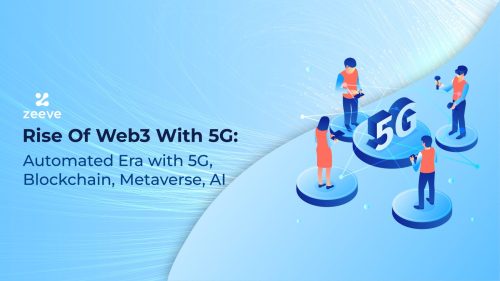
Rise Of Web3 With 5G: Automated Era with 5G, Blockchain, Metaverse, AI
Till 2022, we saw ups and downs in the world of blockchain, and the generation of the internet plays a vital role in the popularity of the technology. In 2023, the fifth generation of the internet will become more and more accessible. 5G is built for device-to-device communication and impacts various technologies such as blockchain, crypto, and DeFi.
The generation of the internet will be more seamless and will have minimal latency. Many enterprises are embarking on leveraging AI, Blockchain, Web3, Metaverse, etc. The emergence of 3D environments is what companies are looking forward to.
The 5G network will enhance digitization, automation, and connectivity between the users, machines, and robots. For instance, the telecast of the sport will be 5G, where we can watch sports with ultra-high definition, an immersive life experience, and various camera angles.
The current 5G internet boosts the usage of IoT, AI, and extended reality (XR), and there will be a massive digital transformation in the coming years. 5G will be the key to the wide adoption of the metaverse. The fourth industrial revolution is now inclining towards 5G enabled. As 86% of the executives are optimistic regarding wireless technology. The 5G will be a conveyor for advocating Web3. Also, 50% of the 5G consumers use extended reality-related services and believe AR will move from smartphones to XR headsets.
In this blog, you will learn more about how life is moving from the Digital era to the automated era with 5G, blockchain, the metaverse, and AI.
Web3 and 5G The Next Wave
You will agree that even a productive employee cannot work if the network is sluggish and has low bandwidth. Nowadays, most businesses have to work online. The early adopters of 5G are likely to adopt future devices. The high latency in the work process disturbs the whole process. 5G (Fifth-generation) wireless is cellular technology and will improve the responsiveness of wireless networks as 5G has more availability.
The 4G long-term evolution (LTE) wireless technology is the foundation of 5G. 5G is being transmitted through high-power cell towers. Due to the use of small stations, the technology generates high speeds. Web3 requires high connectivity, and 5G helps without delays.
Web3 and 5G Propelling the Blockchain
The diversification of the blockchain will improve more in the upcoming years with the rollout of 5G due to some of the reasons discussed:
- 5G will solve one of the biggest challenges of blockchain, which is scalability. The higher the network capacity, the lower the block time generation.
- With 5G’s broadband-level speed, blockchain-enabled services will catch up with the speed of Web 2.0 companies. Therefore, organizations and individuals will slowly become accustomed to the technology and employ it further.
- The Oracles, which happen to be essential for smart contract deployment, require seamless internet access. With the global rollout of 5G, the Oracles will work rapidly. Thus, the usage of smart contracts will become prevalent.
- Undoubtedly, with a better internet, we will witness an improvement in network participation. The active nodes on a network will improve.
- The 5G speed will improve the information exchange between the blockchain and IoT devices.
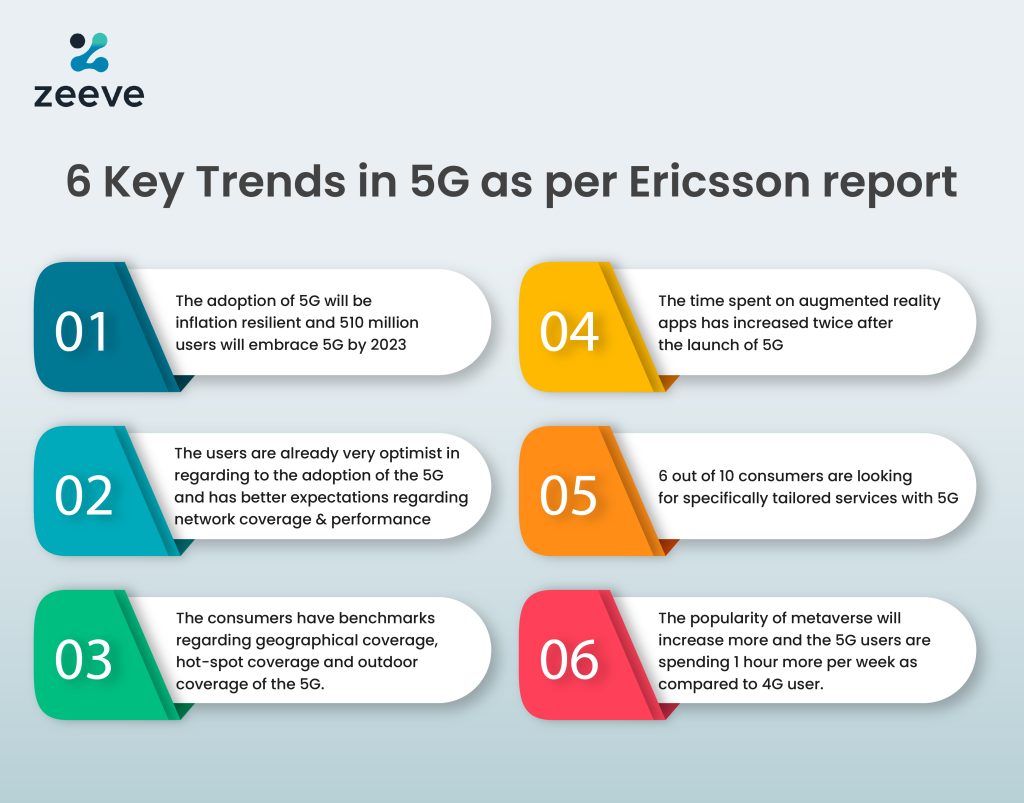
The Need of 5G for Web3
Decentralized protocols like blockchain are used in bitcoin transactions and do not require a middleman. Web3 works on a decentralized network. In Web3, the users can control the web since the community is updated in real-time. Both Web3 and Metaverse leverage blockchain technology and promote decentralization. Web3 has seven components, and Metaverse uses its components along with 5G internet to make the ecosystem interoperable. Web3 combines all the disruptive technologies and AI-enabled analytics to provide data-driven insights.
However, the wide adoption of decentralized architecture will become difficult because there will be high requirements for data integrity and security. The storage requirements will also be higher. There are many advancements in hardware and software technologies. While 5G is there to give high speed, the blockchain’s job will be to ensure decentralization and security. Ultimately, this presents us with sharp device connectivity and low costs.
Businesses that are thinking of integrating blockchain-enabled services to have a better system. The introduction of 5G will improve the connectivity between the linked devices of all the companies embracing the blockchain.
Does Web3 need 5G?
As the Web3 and the metaverse advance, we will need better and better connectivity, while 4G also supports the Web3 and metaverse. 5G, with a speed of 20 Gbps and an average data rate of 100 Mbps, can improve connectivity. 5G can improve network efficiency and traffic capacity. The 5G network creates a linked world and includes machines, robots, and gadgets.
Metaverse works on 5G and uses technologies like AI, blockchain, and AR, VR. Extended reality will connect the digital metaverse, and to take advantage of apps and services, 5G will be vital. The computing will be closer to the end user. There will be better distribution of additional bandwidth required for Web3 and its other components.
In the era of shorter business and product life cycles, a large workforce is more costly to sustain. Currently, companies are focused on the automation of machines and warehouse transportation. Due to 5G’s quick access to many of the NFTs, and decentralized social media networks, metaverse incorporation will be effortless.
Metaverse From 5G
Web 3.0 has become possible because of 4G and will become more prevalent with 5G. The rollout of 5G in recent years has paved the way for gadgets, and machines can operate with minimal human intervention.
The metaverse has avatars, real-time communication, and an immersive world with real-world elements. Furthermore, there is a layer of XR. All of this requires high-speed internet, very similar to that of 5G.
The impact may not be direct, but 5G enhances the quality of the network. The metaverse and the NFTs both become more accessible with 5G. The three different types of communication that make this possible are:
Massive machine-type communication (mMTC)
Machine-type communication happens to be the unique selling point of the technology. It is used to connect many devices and transform IoT devices for eMBB. Machine-type communication is essential when it comes to forming smart cities.
Ultra-reliable low latency communication (uRLLC)
URLLC is ideal for mission-critical applications. The uRLLC has low latency and better network reliability. The industrial remote control will improve with the uRLLC.
Enhanced mobile broadband (eMBB)
The eMBB is an extension of cellular data and provides a speed of 10 Gbps. The high bandwidth usage supports HD video streaming, VR/AR gaming, the metaverse, and improved consumer experience.
Benefits for Enterprise Ready to Embrace 5G
Some of the benefits for enterprises opting for 5G to automate industrial operations are as follows:
More collaboration
Since 5G provides better speed and connectivity, remote teams in an organization can use AR and VR technologies to connect in real time. In addition to connecting over high-quality audio and video. The customer experience can be enhanced by providing them with a personalized shopping experience on Metaverse. The metaverse can also be used for product demonstrations.
More Productivity
The alliance of 5G with Web3 guarantees more productivity because Web3 is considered great for scheduling, resource allocation, forecasting, and optimization. web3 being user-centric and decentralized, can help manage the quality of the products.
Better Security
The relationship between the vendors, suppliers, and end-users is reinvented with the onset of 5G technology. The generation marks a new era for network security since it has an enhanced identity protection mechanism. One of the aspects of 5G that makes it enticing for enterprises and the public is network slicing. In network slicing, the networks have the same infrastructure but are isolated from each other. Therefore, the vulnerability of the system declines.
Precise Management
5G technology can enable businesses to employ sensors and IoT devices to automate enterprise operations. With the use of technology, communication among individuals and organizations improves as well.
Concluding Thoughts
The long-term possibilities of using the blockchain by enterprises and public organizations will be seen in the upcoming years. It should be noted that the troika of Web3, Blockchain, and 5G will be interconnected. The improvement and usage of the technologies will improve as the internet speed increases. 5G and the coming generations of the internet will help us to refine the connectivity and use cases of the technology.
Overall, the deployment of 5G will boost the Web3 industry. The merger between Web3 and 5G will create more revenues for companies.
Partner With Zeeve
If you wish to expand your services and adopt decentralization, partner with Zeeve. We are one of the leading and secure Blockchain Infrastructure management platforms.
We support full nodes and validator nodes for major blockchain protocols. You can opt for Zeeve-managed cloud infrastructure or go for a hybrid deployment. Enterprise and Web 3 startups can choose their own public or private cloud.
We are trusted by more than 23000+ developers, startups and enterprises with 30+ blockchain protocols available including both permissioned and public. If you work with Zeeve, you can have a (Bring your Own Cloud) BYOC, monitoring, and analytics support. You can join our informative sessions and weekly news discussions on Twitter and LinkedIn. Wish to know about our work in detail and connect with us on Telegram. Contact us if you are working on a blockchain-based project and need help.


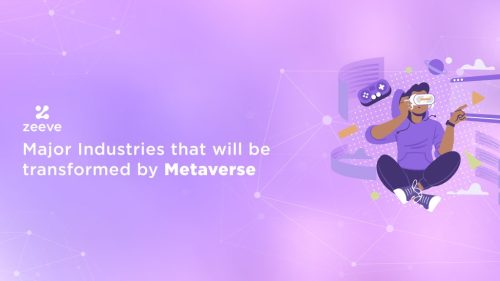

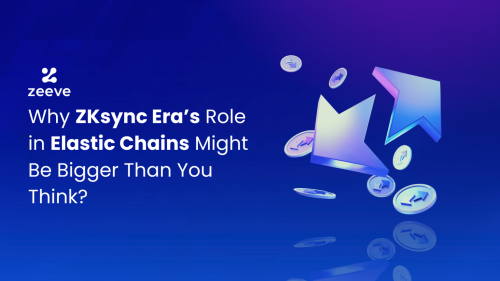
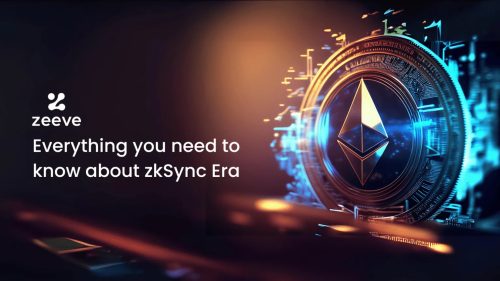
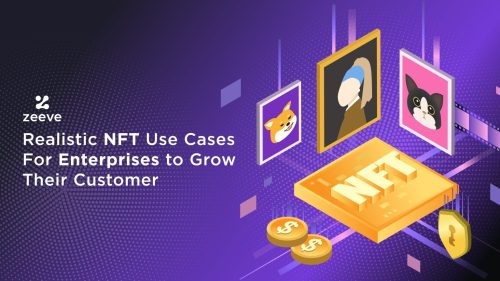
Responses